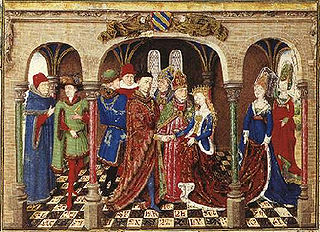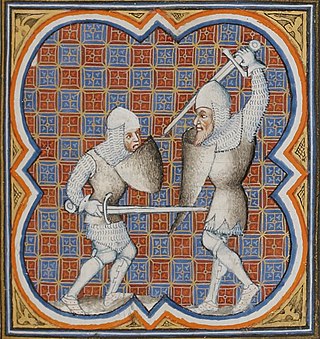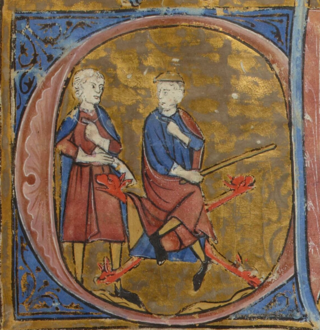
Francisque Xavier Michel was a French historian and philologist.

The chanson de geste is a medieval narrative, a type of epic poem that appears at the dawn of French literature. The earliest known poems of this genre date from the late 11th and early 12th centuries, shortly before the emergence of the lyric poetry of the troubadours and trouvères, and the earliest verse romances. They reached their highest point of acceptance in the period 1150–1250.
Doon de Mayence also known as Doolin de Maience, Doon de Maience or Doolin de Mayence was a fictional hero of the Old French chansons de geste, who gives his name to the third cycle of the Charlemagne romances dealing with the feudal revolts.
Geoffrey of Paris, French chronicler, was probably the author of the Chronique metrique de Philippe le Bel, or Chronique rimée de Geoffroi de Paris. This work, which deals with the history of France from 1300 to 1316, contains 7,918 verses, and is valuable as that of a writer who had a personal knowledge of many of the events which he relates. Various short historical poems have also been attributed to Geoffrey, but there is no certain information about either his life or his writings.

Medieval French literature is, for the purpose of this article, Medieval literature written in Oïl languages during the period from the eleventh century to the end of the fifteenth century.

Girart de Roussillon, also called Girard, Gérard II, Gyrart de Vienne, and Girart de Fraite, was a Frankish Burgundian leader who became Count of Paris in 837, and embraced the cause of Lothair I against Charles the Bald. He was a son of Leuthard I, Count of Fézensac and Paris, and his wife Grimildis.

Pierre Bersuire, also known as Pierre Bercheure and Pierre Berchoire, was a French author of the Middle Ages. A Benedictine, he was a translator, encyclopaedist, and the author of several works, including the Ovidius Moralizatus (1340), a work of mythography. The Gesta Romanorum, a Latin collection of anecdotes and tales, is sometimes attributed to him.

Fierabras or Ferumbras is a fictional Saracen knight appearing in several chansons de geste and other material relating to the Matter of France. He is the son of Balan, king of Spain, and is frequently shown in conflict with Roland and the Twelve Peers, especially Oliver, whose prowess he almost rivals. Fierabras eventually converts to Christianity and fights for Charlemagne.

Ferragut was a character—a Saracen paladin, sometimes depicted as a giant—in texts dealing with the Matter of France, including the Historia Caroli Magni, and Italian epics, such as Orlando Innamorato by Matteo Maria Boiardo and Orlando Furioso by Ludovico Ariosto. In the tales, he was portrayed as physically invulnerable except at his navel/stomach, and was eventually killed by the paladin Roland.

The Historia Caroli Magni, also known as the Historia Karoli Magni et Rotholandi or the (Pseudo-)Turpin Chronicle, is a 12th-century Latin chronicle consisting of legendary material about Charlemagne's campaigns in Spain. The chronicle states it was written by Charlemagne's contemporary Turpin, Archbishop of Reims, but it was found out as a medieval forgery. The work was extremely popular, and served as a major source of material on Charlemagne in chronicles, fiction and iconography throughout Medieval Europe. The miracles of the flowering lances and the death of Ferracutus appear on the windows of Chartres cathedral.

Le Pèlerinage de Charlemagne is an Old French chanson de geste dealing with a fictional expedition by Charlemagne and his paladins. The oldest known written version was probably composed around 1140. Two 15th-century reworkings of the story are also known.

The Paladins, also called the Twelve Peers, are twelve legendary knights, the foremost members of Charlemagne's court in the 8th century. They first appear in the medieval chanson de geste cycle of the Matter of France, where they play a similar role to the Knights of the Round Table in Arthurian romance. In these romantic portrayals, the chivalric paladins represent Christianity against a Saracen (Muslim) invasion of Europe. The names of the paladins vary between sources, but there are always twelve of them led by Roland. The paladins' most influential appearance is in The Song of Roland, written between 1050 and 1115, which narrates the heroic death of Roland at the Battle of Roncevaux Pass.
Agolant or Agolante is a fictional character in Medieval and Renaissance romantic epics dealing with the Matter of France, including Orlando innamorato by Matteo Maria Boiardo and Orlando furioso by Ludovico Ariosto. He is a Saracen king from Africa.

Guillaume le Vinier (c. 1190–1245) was a cleric and trouvère, one of the most prolific composers in the genre. He has left compositions in all the major subgenres of trouvère poetry: chansons d'amour, jeux-partis, a lai, a descort, a chanson de mal mariée and a ballade. He wrote Marian songs and even an imaginary dialogue with a nightingale. His work can be dated with some precision: the poem "En tous tens" is quoted in the Roman de la violette, which was written around 1225.
Aiquin, subtitled La conqueste de la Bretaigne par le roy Charlemaigne, is a medieval Old French chanson de geste about the rivalry between a Saracen king, Aiquin, and the Christian emperor Charlemagne. The French medievalist Joseph Bédier called it a "consolidation of history and legend in an imposing ensemble." It survives in one fifteenth-century manuscript, BnF fr. 2233, now in the Bibliothèque nationale de France. It is usually attributed to Garin Trousseboeuf, possibly a cleric of Dol. According to historian Éric Borgnis-Desbordes, it was written in the early thirteenth century, probably around 1213 and under the guise of a chanson de geste featuring Charlemagne and the Viking invasions in the tenth century, the author may have alluded to “the transition from Plantagenet domination to Capetian influence in Brittany”. It is the oldest extant French text from Brittany.
Jean Courtecuisse was a French bishop and theologian, who was elected bishop of Paris and bishop of Geneva.

Eugénie Droz was a Swiss romance scholar, editor publisher and writer, originally from the Suisse Romande. She created the Librairie Droz, a publisher and seller of academic books, at Paris in 1924, moving the business to Geneva at the end of the war.
The Geste du roi is the title of one of the literary cycles that compose the Chansons de Geste. In the Chansons of the Geste du roi, the chief character is usually Charlemagne or one of his immediate successors. A pervasive theme is the King's role as champion of Christianity. This cycle contains the first of the chansons to be written down, the Chanson de Roland or The Song of Roland.
Jehan de Paris is an anonymous prose romance written at the end of the 15th century, probably around the years 1494–1495.
"The knight who could make cunts speak" is a French fabliau. Seven versions of it remain, including one in MS Harley 2253.












